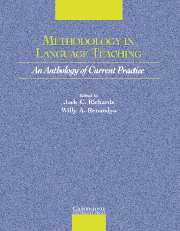Book contents
- Frontmatter
- Contents
- Acknowledgments
- Introduction
- Section I Approaches to Teaching
- Section 2 Lesson Planning and Classroom Management
- Section 3 Classroom Dynamics
- Section 4 Syllabus Design and Instructional Materials
- Section 5 Task and Project Work
- Chapter 9 Implementing Task-Based Language Teaching
- Chapter 10 Project Work: A Means to Promote Language and Content
- Section 6 Learning Strategies
- Section 7 Teaching Grammar
- Section 8 Teaching Pronunciation
- Section 9 Teaching Speaking
- Section 10 Teaching Listening
- Section 11 Teaching Vocabulary
- Section 12 Teaching Reading
- Section 13 Teaching Writing
- Section 14 Assessment
- Section 15 Technologies in the Classroom
- Section 16 Professional Development
- Credits
- Author Index
- Subject Index
- References
Chapter 9 - Implementing Task-Based Language Teaching
Published online by Cambridge University Press: 10 November 2010
- Frontmatter
- Contents
- Acknowledgments
- Introduction
- Section I Approaches to Teaching
- Section 2 Lesson Planning and Classroom Management
- Section 3 Classroom Dynamics
- Section 4 Syllabus Design and Instructional Materials
- Section 5 Task and Project Work
- Chapter 9 Implementing Task-Based Language Teaching
- Chapter 10 Project Work: A Means to Promote Language and Content
- Section 6 Learning Strategies
- Section 7 Teaching Grammar
- Section 8 Teaching Pronunciation
- Section 9 Teaching Speaking
- Section 10 Teaching Listening
- Section 11 Teaching Vocabulary
- Section 12 Teaching Reading
- Section 13 Teaching Writing
- Section 14 Assessment
- Section 15 Technologies in the Classroom
- Section 16 Professional Development
- Credits
- Author Index
- Subject Index
- References
Summary
INTRODUCTION
Language instructors and curriculum designers can choose from two broad categories of syllabuses. The first, the synthetic syllabus, segments the target language into discrete linguistic items, such as points of grammar, lexical items, and functions. Users of this type of syllabus assume that learners will be capable of resynthesizing these discrete pieces of language into a coherent whole which can then be effectively utilized in communicative situations (White, 1988). The second type, the analytic syllabus, is a noninterventionist, experiential approach which aims to immerse learners in real-life communication. It provides learners with samples of the target language which are organized in terms of the purposes for which people use language. In this case, the assumption is that the learners' analytic abilities will be equal to the task of coming to accurate conclusions about grammatical and lexical usage, since relatively little may be explicitly explained about the formal aspects of the language. Analytic syllabuses generally represent the educational value system espoused by progressivism, which stresses the growth and self-realization of the individual (White, 1988). This is a problem-posing type of education which emphasizes dialogue between learners and teachers and between the learners themselves. The purpose of the dialogue is to stimulate new ideas, opinions, and perceptions rather than simply to exchange them or regurgitate what others have said.
- Type
- Chapter
- Information
- Methodology in Language TeachingAn Anthology of Current Practice, pp. 96 - 106Publisher: Cambridge University PressPrint publication year: 2002
References
- 8
- Cited by

